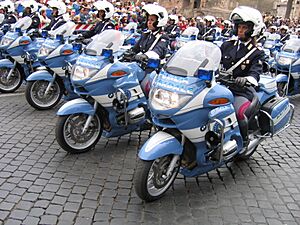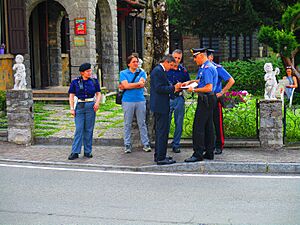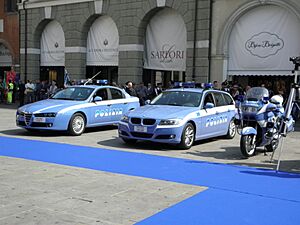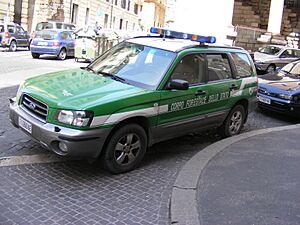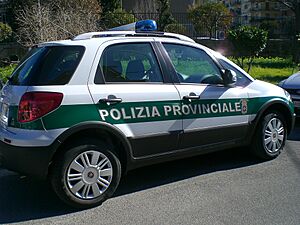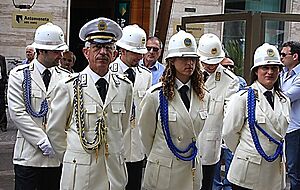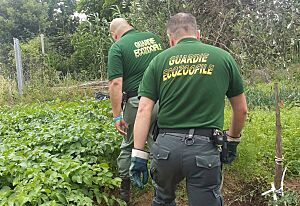Law enforcement in Italy facts for kids
Keeping Italy safe is a big job! In Italy, many different police forces work together to make sure laws are followed. It's a bit like having different teams, each with special skills, all working for the same goal.
The main police forces in Italy are the Polizia di Stato (State Police), the Carabinieri, the Guardia di Finanza (Financial Guard), and the Polizia Penitenziaria (Prison Police). These groups have officers who can investigate crimes and make arrests. There are also smaller local police groups that help out.
The two biggest police forces are the Carabinieri, who are a military police force, and the Polizia di Stato, which is a civilian police force. The Guardia di Finanza is another military police group that focuses on money-related crimes like tax evasion and smuggling. These main forces are organized across Italy's provinces, working under local police chiefs.
Italy's law enforcement system is managed by the Ministry of the Interior. The Carabinieri also act as military police for Italy's armed forces. They have stations all over the country, even in small towns and along highways. In 2005, Italy had over 324,000 police officers, which was the highest number in the European Union at that time!
Italy's National Police Forces
Polizia di Stato: The State Police
The Polizia di Stato is Italy's main civilian police force. They do many important jobs, like patrolling streets, investigating crimes, and keeping the peace. They also look after safety on Italy's highways, railways, bridges, and waterways.
Even though they are a civilian force, they have a very organized structure, a bit like the military. Their main office is in Rome, but they have branches in every region and province across Italy.
The Polizia di Stato also has a program called Polizia di Quartiere, which means "Neighbourhood Police." This program puts police officers on foot or bikes in major cities to help prevent crime and be more visible in communities.
Guardia di Finanza: The Financial Guard
The Guardia di Finanza is a military police force that works under the Ministry of Economy and Finance. Their special job is to deal with financial and economic crimes.
They investigate things like:
- Tax evasion (people not paying their taxes)
- Financial crimes (like fraud)
- Smuggling (bringing illegal goods into the country)
- Money laundering (making illegally earned money look legal)
- Illegal immigration
- Customs and border checks
- Copyright violations
- Anti-Mafia operations
- Credit card fraud
- Cybercrime
- Counterfeiting (making fake money or goods)
- Terrorist financing
The Guardia di Finanza has about 68,000 members. Some of their officers also work with international groups like Europol and Eurojust to fight crime across Europe. Their motto, Nec recisa recedit, means "Not Even Broken Retreats." They also use boats, ships, and aircraft to patrol Italy's waters and borders.
When there are big public events or protests, the Guardia di Finanza often helps with crowd control.
Arma dei Carabinieri: The Military Police
The Carabinieri are a military police force, similar to a gendarmerie. They have two main roles: they act as regular police for civilians, and they also serve as military police for Italy's armed forces. They can be called upon to help with national defense.
The Carabinieri are now a separate branch of the Italian armed forces, alongside the Army, Navy, and Air Force. They are often called the Arma or La Benemerita, which means "The Meritorious Corps."
Carabinieri units have been sent all over the world to help with peacekeeping missions in places like Bosnia, Kosovo, Afghanistan, and Iraq. Until 2001, only men could join the military in Italy, but now women can also serve in the Carabinieri.
Because they have both military and civilian police duties, the Carabinieri are often called to help with crowd control during large events and demonstrations. They have many police stations across Italy, making them very present in communities.
Polizia Penitenziaria: The Prison Police
The Polizia Penitenziaria, also known as the Prison Police Corps, is in charge of Italy's prisons. Their job is to keep prisons secure, ensure the safety of inmates, and manage the transfer of prisoners between different locations.
Their officers sometimes help other police forces during big events. This force is part of the Ministry of Justice and works nationwide to keep prisons safe and secure.
Corpo Forestale dello Stato (No Longer Active)
The Corpo Forestale dello Stato (National Forestry Department) used to be responsible for enforcing laws in Italy's national parks and forests. They helped protect animals, prevent poaching, and fight forest fires.
This civilian police force was founded in 1822 and specialized in protecting the environment. They also managed activities related to the CITES agreement, which controls trade in endangered species.
However, the Corpo Forestale dello Stato was closed down on December 31, 2016. All its members became part of the Carabinieri's special unit for forest, environmental, and food protection.
Interforces: Working Together
The Direzione Investigativa Antimafia (DIA), or Anti-Mafia Investigation Directorate, is a special group where officers from the Polizia di Stato, Carabinieri, Polizia Penitenziaria, and Guardia di Finanza all work together. Their main goal is to fight organized crime, like the Mafia.
Founded in 1991, the DIA works to stop criminal groups from getting involved in the government. They investigate how these groups operate and their connections both inside and outside Italy.
Italy's Interpol office, which helps with international police cooperation, is also a team effort. It includes officers from the Polizia di Stato, Carabinieri, and Guardia di Finanza, all working together to share information and catch criminals across borders.
Local Police Forces
Besides the national police forces, local communities in Italy also have their own police groups.
These are usually:
- Provincial Police (Polizia Provinciale)
- Local or Municipality Police (Polizia Locale)
Provincial Police
The Polizia Provinciale (Provincial Police) operates in some of Italy's provinces.
Their main jobs include enforcing hunting and fishing laws in their areas. They also help with wildlife management and protecting the environment. They can also assist with traffic control and other security services.
Municipal and Local Police
Every town and city in Italy has its own Polizia Municipale (Municipal Police). Their main duties are controlling traffic and enforcing local rules and licenses.
The municipal police also help the national police forces with local crime prevention and community safety. Their authority is limited to their specific town or city.
Regional Forces in Sardinia and Other Autonomous Regions
Some special regions in Italy, called Autonomous Regions, have their own local police forces that report to the regional government. Their authority covers the entire region or specific municipalities within it.
For example, the island of Sardinia has its own Corpo forestale e di vigilanza ambientale (Forestry and Environmental Surveillance Corps) since 1985. This means Sardinia handles its own laws about nature, parks, and fires. Also, because Sardinia has many farms, most towns have a Corpo Barracellare. These are volunteer civilians who help deal with animal theft or farm damage when needed by the local government.
Animal Protection
In some parts of Italy, there are special groups called Guardie Zoofile (Animal Protection Guards). These volunteers rescue animals in trouble and protect animals and wildlife. They receive training and have limited powers to ensure animal safety.
These agents check that people are following all local, regional, and national laws about animals. If they find a problem, they can report it to the Carabinieri, Polizia di Stato, Polizia Locale, or Forestry Carabinieri.
Uniforms and Equipment
Guardie Zoofile agents usually wear green uniforms, which might include:
- A beret, mountain cap, or baseball cap (green or black)
- A shirt or polo shirt (green or black)
- Cargo trousers (green or black)
- A bomber jacket (green or black)
- Black boots
- A duty belt with a radio, handcuffs, and gloves
Some agents carry firearms, usually pistols, while others do not. There is also a more formal uniform that some agents wear, similar to a suit. Vehicles used by the Guardie Zoofile are usually marked with their name and have blue lights and sirens.
Transportation
For a long time, Italian police forces mainly used cars made in Italy, especially Alfa Romeos. A Polizia di Stato patrol car is often called a Pantera (Panther), and a Carabinieri car is called a Gazzella (Gazelle).
All police forces use helicopters, trucks, and campers (which can be used as mobile offices). In Venice, where the city is built on water, police and firefighters use boats to get around. In 2004, Lamborghini even gave two Lamborghini Gallardo sports cars to the Polizia di Stato for special emergencies!
Here's how you can tell the different police vehicles apart:
- Carabinieri patrol vehicles are dark blue with a red stripe. Most have white roofs. Their emergency number, "112," is on the side. Their license plates start with "CC."
- Guardia di Finanza vehicles are dark grey with a thin gold stripe and "Guardia di Finanza" written in gold. Their license plates start with "GdiF" in red.
- Polizia di Stato vehicles are light blue with a white stripe and "POLIZIA" in large letters. Their license plates usually start with "Polizia" in red.
- Polizia Penitenziaria vehicles are dark blue with a light blue stripe and "Polizia Penitenziaria" in white letters. Their license plates have the full name "POLIZIA PENITENZIARIA."
- Corpo Forestale dello Stato vehicles (now used by Carabinieri) were green with a white stripe and "CORPO FORESTALE DELLO STATO." Now they say "CARABINIERI" but keep the green and white colors. Their old license plates started with "CFS."
- Polizia Provinciale vehicles are white with a green stripe.
- Polizia Municipale vehicle colors can vary by region. They are usually white with blue, green, or red stripes and "Polizia Municipale" or "Polizia Locale" written on the side. Some can be black or dark grey. Their license plates have "POLIZIA LOCALE."



